Napoleon’s Irish Legion
Published in 18th–19th - Century History, Features, Issue 5 (September/October), Volume 22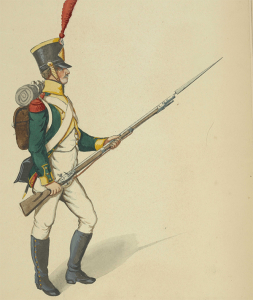
The green uniform with parchment yellow facings of a light infantryman in Napoleon’s Légion Irlandaise. (New York Public Library).
Coastal defence in Brittany
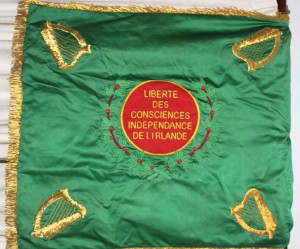
‘Freedom of Conscience/ Independence of Ireland’—the Legion’s flag or ‘colour’.
Following the defeat of the Franco-Spanish fleet at Cape Trafalgar in 1805, the anticipated invasion of the British Isles was cancelled and the Irish unit was instead ordered east to join the German campaign in Mainz, where France was at war with Austria and Russia. While marching through the French town of Verdun, the Irish legionnaires became aware of the presence there of British prisoners of war; they proudly unfurled their colour and uncovered their eagle while the Legion band belted out their regimental air, Saint Patrick’s Day, to the astonishment of British prisoners billetted in the town. While stationed in Mainz, they were joined by c. 1,500 Poles and 200 former United Irishmen who had been sold by the British government as indentured mine labourers to Prussia after the 1798 Rebellion. Thereafter, with so many foreigners joining its ranks, the Irish Legion became a truly European unit, comprising many different nationalities, officered by Irishmen; it was later renamed the 3rd Foreign Regiment (Irish) and raised to a four-battalion regiment.
The Peninsular War, 1807–14
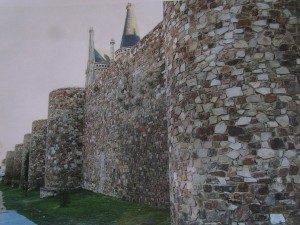
The walls of Astorga, with its cathedral behind, close to the breach (top left-hand corner of the walls on the map, above) stormed by Irish Legionnaires on 21 April 1810. The action was to earn them their highest battle-honours.
The Irish were tasked with dangerous counter-insurgency activities, such as hunting down Spanish insurgents in the mountains of Castille and Asturias. It was a task the former United Irishmen didn’t relish, as they sympathised with the guerrillas as patriots and drew analogies with their own experiences of being hunted by the British in the Wicklow Mountains in the recent Irish risings.
In 1809, as an Irish advance post was marching out from the northern Spanish town of Burgos, their distinctive green uniforms impressed Napoleon, who pulled up his horse and asked Sergeant Mooney what regiment he belonged to. Thereafter, Mooney and his twelve men never passed up an opportunity to mention that they had been inspected by the emperor himself! Mooney and his men must indeed have made a good impression, as they were chosen to provide an escort guard for Napoleon at his lodging before being relieved by his personal bodyguards, the veteran bearskinned Imperial Guard.
Siege of Astorga
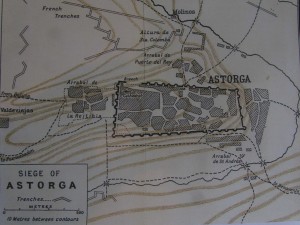 The Irish were assigned to General Junot’s Army of Portugal in 1810 and were heavily engaged at Almeida and Fuentos de Oñoro, but their actions in the Spanish town of Astorga were to be their highest battle-honour. In April Junot’s 8th Corps placed Astorga under siege, as it was strategically located on the flank of the French invasion of Spain and Portugal. The town’s walls were breached after five days’ pounding by the French guns, and an Irish detachment was selected to lead the assault battalion.
The Irish were assigned to General Junot’s Army of Portugal in 1810 and were heavily engaged at Almeida and Fuentos de Oñoro, but their actions in the Spanish town of Astorga were to be their highest battle-honour. In April Junot’s 8th Corps placed Astorga under siege, as it was strategically located on the flank of the French invasion of Spain and Portugal. The town’s walls were breached after five days’ pounding by the French guns, and an Irish detachment was selected to lead the assault battalion.
On the evening of 21 April, a body of advance troops drawn from the 47th Regiment of the Line and 150 Irish Voltigeurs (élite light infantry) debouched from their trenches to the rum-dum-dum drumbeat of the pas de charge and shouts of ‘Vive l’Empereur!’ Captain John Allen, a Dubliner, headed a party of volunteers (known as a ‘forlorn hope’ because they had little chance of surviving) who would be the first to storm the breach. Allen, who had fought in the 1798 Rebellion, led his Irish company of Voltigeurs 200 yards through a hail of grapeshot and close-range musket fire until they reached the ditch at the town’s walls. Allen was first to mount the breach and, followed by the ‘forlorn hope’, clambered up the wall through thick white musket smoke. He then turned and saluted the French General Junot, raised his sword and urged his Irish Voltigeurs to follow. The ‘forlorn hope’ was quickly followed by the assault battalion, who took possession of a house just behind the rampart and held their position all night while under heavy fire and enemy attack. By morning, the Spanish garrison raised the white flag.
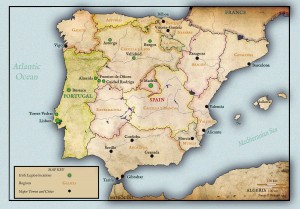
The storming of Astorga’s breach had taken a heavy toll, leaving 112 dead and 294 wounded. Three Irishmen were decorated with France’s highest military decoration, the Legion of Honour— Captain Allen, Lieutenant Perry for carrying a scaling ladder to the wall, and a drummer who, despite being severely wounded in both legs, continued to beat the charge. Allen’s men were the talk of the army for their death-defying courage, and the 1,000-strong 2nd and 3rd Irish battalions were given the honour of being the first troops to march triumphantly through the city’s gate. The bearded and weather-beaten Irish Legionnaires, their uniforms ragged and frayed, were still exhausted after weeks in the trenches when they were detailed to escort the surrendered 5,000-man garrison on their two-day march on the hot and dusty road to Valladolid.
The Irish were disappointed not to have engaged a British army under General Sir John Moore, as several officers had fought Moore in Ireland in ’98 and were eager to settle the score, this time on equal terms. But in the ridges above the Portuguese town of Bussaco in 1810 they confronted an Anglo-Portuguese army under Arthur Wellesley, the duke of Wellington. The Irish 88th Foot (Connaught Rangers) in the British army led the assault in the battle and pushed the retreating French columns, including the two Irish battalions, down the mountain. One can imagine the scene, with both Irish regiments playing the same exhilarating regimental air of St Patrick’s Day to rally their troops but from opposite sides!
Wellington was forced to retreat towards Lisbon, and the Irish, being light troops, formed the advance posts of the French 8th Corps that pursued him to the Lines of Torres Vedras outside Lisbon. The poorly supplied French army dug in there but was forced to pull back to Spain; the Irish formed the rearguard and covered their retreat. After sustaining heavy losses through disease, the Irish Regiment was ordered back to France—a sad, inglorious end to their four-year tour of duty in the Iberian Peninsula.
The Low Countries campaign
While the Legion’s 2nd and 3rd battalions received their baptisms of fire in Spain, the unblooded 1st Irish battalion had remained on coastal defence duty in France before being ordered in 1809 to repel a huge British invasion force that landed in Walcheren Island in the Low Countries.
The French were forced to pull back to the nearby town of Flushing, which was soon flattened by heavy bombardment. The 1st Irish battalion, although heavily outnumbered, held their advance positions for several days before the entire French garrison, including the Irish contingent, were finally forced to surrender. The Irish commander, Colonel Lawless, along with Lieutenant O’Reilly and other Irishmen saved their cherished imperial eagle from capture and made a daring escape back to their own lines. As Lawless was the highest-ranked officer to escape from Flushing, he was invited to Paris to present the eagle personally to Napoleon; both he and O’Reilly were promoted and received the Legion of Honour.
The Irish join La Grande Armée
The Irish luckily missed Napoleon’s disastrous retreat from Moscow. The minister for war, General Henri Clarke (who was born in France to Irish parents), ordered the reformed 2,000-strong Irish Regiment to join the Grande Armée’s 5th Army Corps in Magdeburg, Germany, where they fought bravely at Reichenbach in clashes with irregular Russian Cossack cavalry in vicious hit-and run attacks. One of Napoleon’s most famous generals, Marshal Ney, reprimanded Sergeant Costello for not falling back immediately when the trumpet was sounded to retreat. Costello said that a Cossack had fired twice at him and that he wanted to kill the fellow before quitting the field. ‘And did you kill him?’ asked the marshal, who was pleased. ‘I hope so,’ replied Costello, ‘for I saw him fall from his horse.’
In support of Marshal MacDonald’s division they fought gallantly and lost 400 men in Lowenberg. Sergeant Costello had an arm blown clean off, Captain Tennant was literally cut in two by a cannon ball, while Napoleon witnessed Colonel Lawless’s leg being carried off by a cannon ball and sent his chief surgeon to amputate what remained of the shattered limb. This was a painful procedure with which Lawless would have been all too familiar as a former professor at the Royal College of Surgeons in Dublin. In 1813 the Irish formed part of General Puthod’s division and again lost heavily at the Battle of Kulm. The French were forced to fight a rearguard action before a Russo-Prussian army of 30,000 launched a massive frontal assault and forced them into the Bober River. Only a few French companies escaped, including just eight Irish Legionnaires, who again saved the regiment’s eagle and honour in spite of this decisive defeat.
In 1814 the British sent a large army into the French-occupied Low Countries to defeat Napoleon by besieging Antwerp, then a leading shipbuilding port in the First French Empire. Antwerp was defended by the Irish Regiment, who stood firm during the three-month siege but in the end were forced to give up the city after Napoleon’s abdication. The Irish Regiment was under strength and not battle-ready for the decisive engagement at Waterloo the following year; the siege of Antwerp proved to be the last major Irish action, the last Irish ‘huzza’ on the Continent. The Irish Regiment was disbanded when Napoleon went into exile after Waterloo, bringing to a close a 125-year-old tradition of Irish service in France. All regimental property, including their flags and battalion eagles, were destroyed. The rank-and-file were sent to the 4th Royal Foreign Regiment (the forerunner of the famous French Foreign Legion), based in Toulon. The Irish officer cadre was finally lost to France forever, although a few officers managed to remain to serve in other regiments.
Stephen McGarry is the author of Irish Brigades abroad (Dublin 2013).
Read More: The Irish military tradition
















